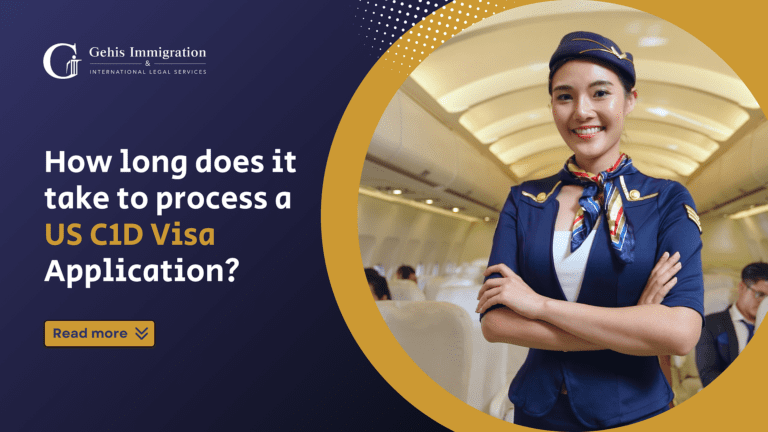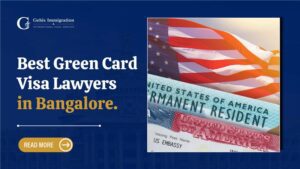US C1D Visa Application Process
US C1D visa Application Process is required for crew members of multinational vessels and planes visiting the United States for employment. It is a nonimmigrant visa that combines the C1 visa, used for travelers transiting through the United States, with the D visa, intended for crew members working on vessels or airplanes temporarily visiting the United States.
This visa permits international crew members to enter the United States for brief durations linked to their work without the onerous formalities required by other visa types. Pilots, flight attendants, sailors, engineers, and other workers involved in the operation and repair of international flights and ships are among the most common candidates.
The processing time for the US C1D visa is important for applicants since it directly impacts their capacity to perform their work duties. Airline crew members must coordinate their visa processes with flight schedules, while sea vessel crew members must guarantee they may join their boats at US ports without delay. The processing period impacts travel arrangements, as applicants must schedule flights or ship departures around predicted visa approval timelines.
Delays in processing might result in lost connections or delayed deployments, impacting both business and personal schedules. Employers frequently organize crew rotations or shift schedules based on visa issuance dates to prevent staffing shortages and promote effortless operational continuity. Understanding the projected duration of the visa procedure benefits both applicants and their employers.
What is the US C1D Visa Application Process?
Obtaining a C1D visa involves specific eligibility criteria and a structured application procedure. To be eligible for the C1D visa, applicants must be crew members on international airlines or sea vessels traveling to the United States. They must demonstrate that their entry is directly related to their employment duties, such as managing passengers or maintaining the vessel, and they must intend to leave the U.S. upon completing their duties.
Required documentation includes a valid passport, a completed DS-160 form (which includes personal information, travel plans, and employment details), a recent passport-sized photograph, a letter from the employer confirming their role, details of travel plans, and evidence of ties to their home country, such as employment contracts or property deeds.
The first step is completing the DS-160 form online, which generates a confirmation page to be brought to the consular interview. Applicants then schedule and attend an interview at the U.S. embassy or consulate, where they must present their confirmation page, passport, and supporting documents. The consular officer assesses the application and interviews to verify the purpose of the visit and eligibility.
In some cases, biometrics, including fingerprinting and a photograph, are collected during the interview, and a medical examination may be required, particularly if the applicant’s job involves specific health concerns. Following these steps carefully helps ensure a smooth application process and reduces the likelihood of delays in obtaining the C1D visa.
What are The Factors Affecting US C1D Visa Application Process?
Several factors can influence the processing time for a C1D visa, ranging from the consulate’s workload to the completeness of the application, as well as security checks and special circumstances.
Consulate Workload
Processing times for C1D visas can vary significantly depending on the consulate’s workload, which often fluctuates by location and season. For instance, consulates in major cities or regions with high travel volumes may experience longer wait times due to increased application submissions. Seasonal surges, such as during peak travel periods or holiday seasons, can also contribute to longer processing times. Consequently, applicants might experience different waiting periods depending on the specific consulate handling their application and the time of year they apply.
Completeness of Application
The application’s accuracy and completeness are crucial in determining processing time. Submitting accurate and thorough documentation is essential; discrepancies or missing information can lead to significant delays. Common reasons for delays include incomplete forms, incorrect information, or insufficient supporting documents. The processing time may be extended if the consular officer requires further clarification or additional documentation. Ensuring all required documents are provided, and all questions are answered correctly can help streamline the application process.
Security and Background Checks
Security and background checks are standard procedures in visa processing, and they can vary in duration based on the applicant’s history and nationality. These checks verify the applicant’s identity and assess potential security risks. Depending on the complexity of the background check, including factors such as previous travel history or employment records, the process can take a few days to several weeks. Applicants with names or backgrounds that raise flags may experience longer processing times due to the need for more in-depth investigation.
Special Circumstances
Certain situations may necessitate expedited US C1D visa application Process, particularly in cases of urgent travel or critical employment needs. For example, crew members who must join their vessel or flight imminently may request expedited processing, which can shorten the usual waiting period. Global events like the COVID-19 pandemic have impacted visa processing times by causing delays and increasing wait times due to health and safety restrictions. Consulates may implement temporary measures or protocols that affect how quickly visas are processed during such events. Awareness of these factors and planning accordingly can help applicants manage the potential challenges associated with processing times for the C1D visa.
Challenges and Tips For US C1D Visa Application Process
Applying for a C1D visa can be challenging, but thorough preparation and communication can help. Common issues causing delays include:
- Incomplete or inaccurate DS-160 forms
- Missing documentation, such as employment verification or travel itineraries
- Inadequate preparation or inconsistent answers during the interview
- Forgetting required documents
To avoid these issues, applicants should carefully complete the DS-160 form, gather all necessary documents, and prepare for the interview.
To ensure a smooth US C1D visa application process, applicants should carefully prepare their documents, review all requirements, and double-check the accuracy of the DS-160 form. Organize supporting documents like employment verification and ties to the home country. Communicate effectively with the consulate, following instructions and seeking clarification if needed. Many consulates offer support services. Keep track of the application status and respond promptly to requests to prevent delays. By being meticulous, communicating effectively, and staying proactive, applicants can manage the process efficiently and reduce delays.
Obtaining a C1D visa involves understanding processing times and factors that influence them. Typically, processing takes 1-2 weeks, but can vary based on consulate workload, application completeness, and security checks. Errors, missing documents, and interview inconsistencies can delay the process. However, expedited processing may be available for urgent situations if applicants can justify their immediate need.
To manage the US C1D visa application process effectively, plan ahead and allow time for potential delays. Gather all required documents meticulously and complete the DS-160 form accurately. Utilize official consulate websites, support services, and online tools to stay informed. Communicate effectively with the consulate and respond promptly to requests to avoid delays. By staying informed and proactive, applicants can reduce the risk of complications and successfully navigate the application process.






